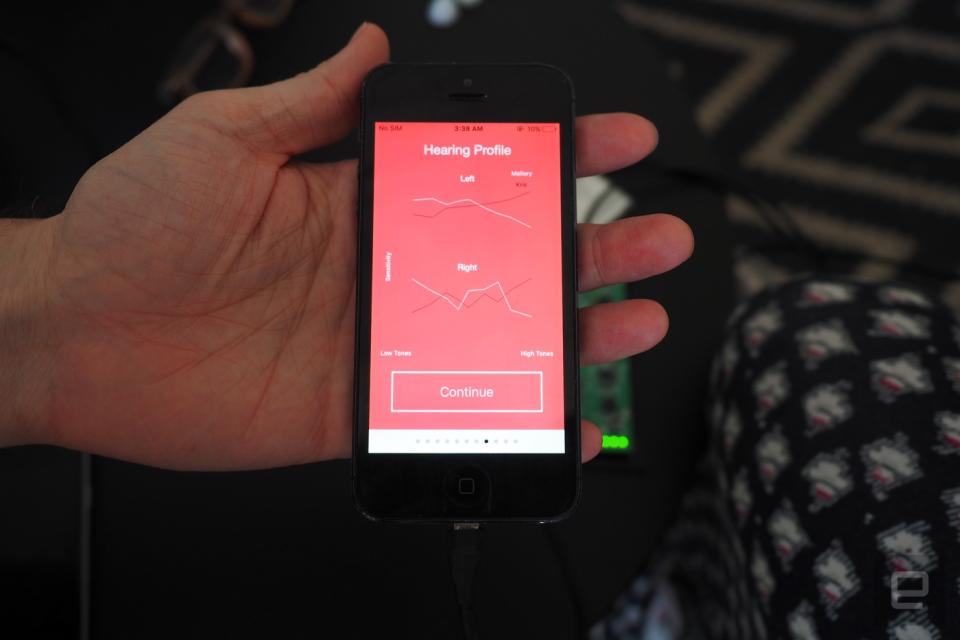The Nura headphones craft the perfect audio for your ear
But they'll sound like crap to everyone else.

Any time you buy a new pair of headphones, you probably spend a bit of time tweaking their fit and feel for the best listening experience. That can mean adjusting the headband or swapping out the earbud tips to ensure the best fit. But the sound quality itself is still mostly a one-size-fits-all experience. Sure, you can fiddle with the settings on your audio device, and some headphones have built-in equalizers or "bass boost" buttons. But there's still a lot of guesswork involved, and most of us aren't going to invest that much effort in getting it right. The Nura headphones seek to eliminate all the uncertainty and compromise by packing in hardware that can calculate your perfect sound profile based on the shape of your inner ear, no equalizer required.
At first glance, you can see something's up with the Nura. Sure, from one angle they look like a standard pair of over-ear headphones. Peek underneath, however, and you'll see a pair of in-ear buds jutting out from the inside of each cup. This might seem odd and even a bit redundant, but it's essential to building out the Nura's sound profile. Because inside each bud is a small microphone that the device uses to listen to the inside of your ear. What is it listening for? Well, according to Nura CTO Dr. Luke Campbell, sounds going into your ear generate an aural response from your cochlea. Not an echo -- this is an entirely new sound that contains a wealth of information about the shape and condition of your inner ear. The Nura can then figure out what kind of audio will sound best to you and adjust the sound coming from the headphones accordingly.
It isn't automatic, though. There's a bit of setup involved, but the companion app keeps things simple. Once you select "new user" on the main screen, it'll walk you through the process, even reminding you to make sure the headphones are seated correctly on your head. You'll hear a series of tones -- akin to the dial tone on a phone rather than the beeps in your typical hearing test -- and then the app will take the data it just gathered and create a profile for you. That profile will be stored in the headphones themselves, meaning you can use any media player with the Nura; the only reason you'd need to reopen the app is if you need to set up another profile or want to compare multiple users. But even on that last point, a button on the headphones themselves will let you bounce between your profile and a friend's profile, as well as the "Kick It" feature, which is sort of like a bass boost.

Most of the audio is projected through the earbuds, but the outer ear cup serves a purpose as well: That's where the bass makes its appearance. Instead of simply making those frequencies louder and more prominent in the audio profile, the headphones vibrate on your outer ear, enhancing your perception of the low end and making it seem more intense without actually pumping up the volume.
I was the kid who always failed hearing tests in elementary school, so my first experience with the Nura brought back a lot of uncomfortable memories. The app was quick to remind me that I needed to push in the earbuds more to get an accurate reading: If you don't like in-ear phones that fit inside your ear canal, you're probably not going to enjoy the setup process. Nor will you get the best sound from the Nura if you're not willing to push them in every single time. Within a minute or two, my sound profile had been created and I hopped into some of the included tracks on the app, starting with Björk's "Venus as a Boy."

It sounded hollow and metallic to me, which didn't bode well. Then I saw that it was set on the generic profile. With my personalized settings enabled, the difference was astounding. Sure, it sounded louder, but the audio was also clearer and more level. The lows, mids and highs were all audible and didn't feel like they were competing with each other for my attention.
The next step was to try it with a song I was more familiar with. I probably spend an unhealthy amount of time listening to the Guardians of the Galaxy soundtrack, so "Hooked on a Feeling" by Blue Swede seemed like a good choice. It has varied vocals and instrumentation and, being an older song, it's not as heavily processed as modern tracks. It shone on the Nura, with the voices sounding full and resonant, while the horns were bright and clear. I was hearing more of the music than I normally would, which meant I was finding unfamiliar nuances. But it was also a bit disconcerting, because these are things I wouldn't normally hear and maybe don't need to hear. It's similar to the visual spectrum: Sure, maybe it would be cool if I could see infrared or ultraviolet, but I don't really need to. There are also situations where I wouldn't even want to, like hotel rooms. I worry about the potential for "hotel room" situations in songs.

However, Nura isn't really about helping you uncover the hidden secrets in songs. It's about crafting the perfect profile for you, and to see that difference you need a point of comparison. So I brought along our social media editor and music theorist Mallory Johns. Mallory is a self-confessed audiophile, the kind of person who brings earplugs to concerts to protect her hearing. So presumably her profile would be very, very different from mine.
Mallory went through the setup as I did, and started on J. Cole's "G.O.M.D." That's a very bass-heavy track that really highlights the Nura's over-ear capabilities. "Whoa," she said. A lot. I watched her switch between profiles and tracks, also taking Radiohead's "Burn the Witch" for a spin. Overall, she thought it sounded "super clear and pronounced," but perhaps the biggest impact was the difference between the two of us. She said my profile sounded "really loud," which made more sense after I later listened to her profile.

You see, between my history of hearing issues, my lack of care to protect the hearing I do have and our age difference (I'm seven years older), I have worse hearing than Mallory, which the Nura compensated for. Her profile sounded clear to me, but also very low and maybe even a little muffled. Nura COO Dragan Petrovic told us that sometimes other users' profiles can sound muddy. The Nura was even tested on two brothers with very different profiles, who got into a fight about how "crap" the other's profile sounded. Of course, it's a silly fight to have, because it isn't a matter of personal taste with the Nura: The headphones are doing all the decision making about audio quality for you.
There's something incredibly refreshing about that: In college I used to spend hours fiddling with audio settings, only to change them a few days later because something just wasn't right. As I've gotten older, not only has my hearing changed, but I also have less time to worry about what things sound like: I just want to pop a pair of headphones on my head to listen to my music as I commute to the office. So in a way the Nura is basically giving me a piece of my youth back, not just by showing me what music could sound like, but what it used to sound like when I had better ears and time to take advantage of them.
The Nura hits Kickstarter today with an early-bird price of $179. Once that batch runs out, backers can snag a pair for $249, which is still a significant discount from the eventual retail price of $399. With many audiophile headphones going for thousands of dollars, that's a pretty good deal for a set that promises great sound and will do all the legwork to deliver it to you.














